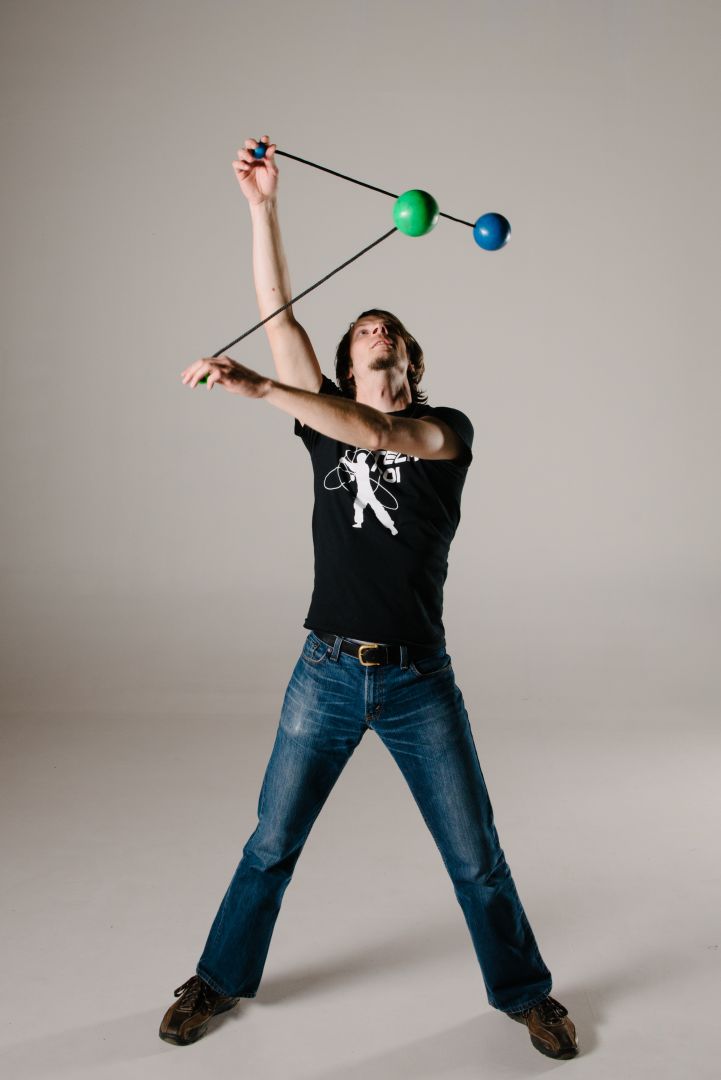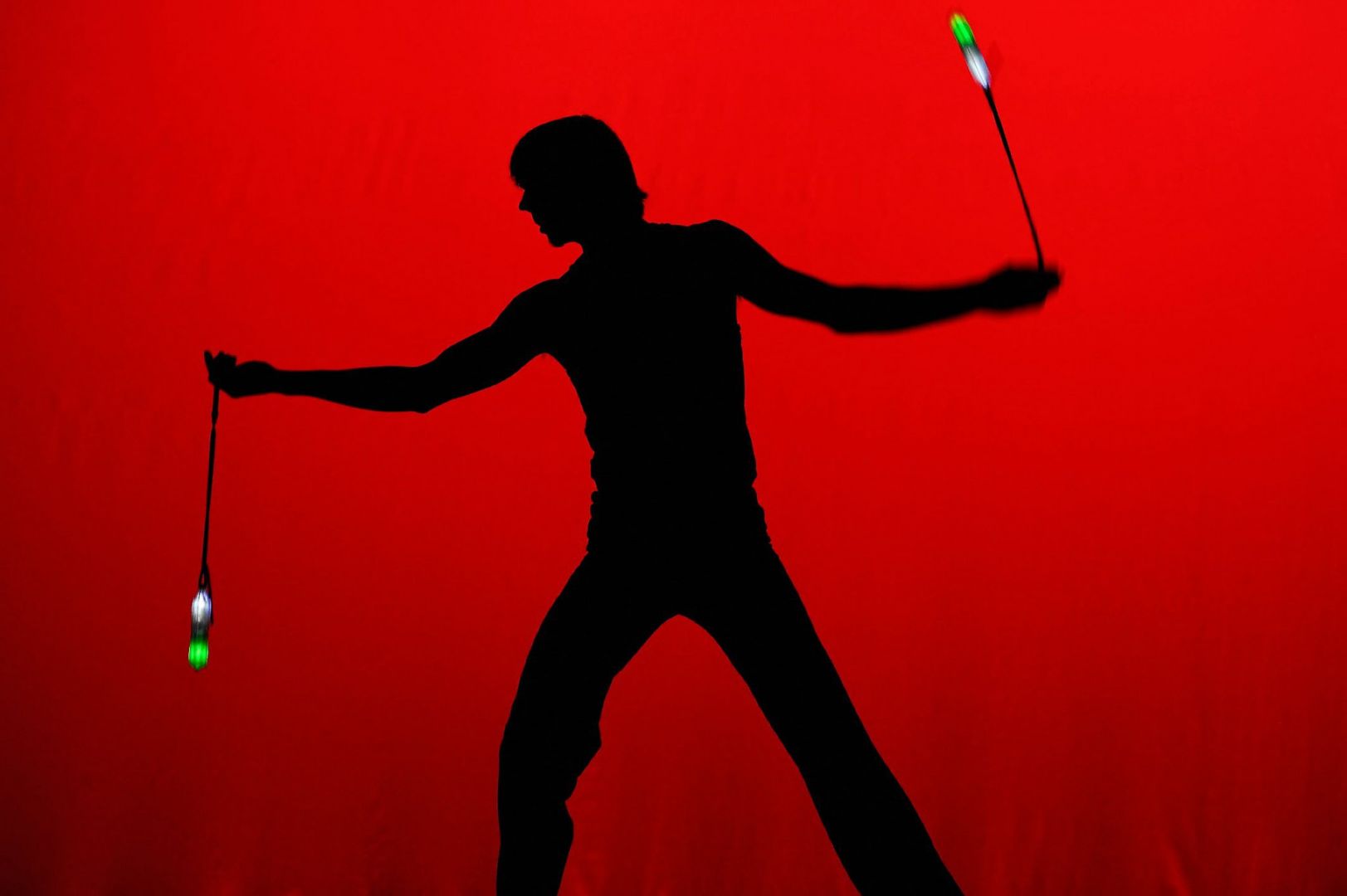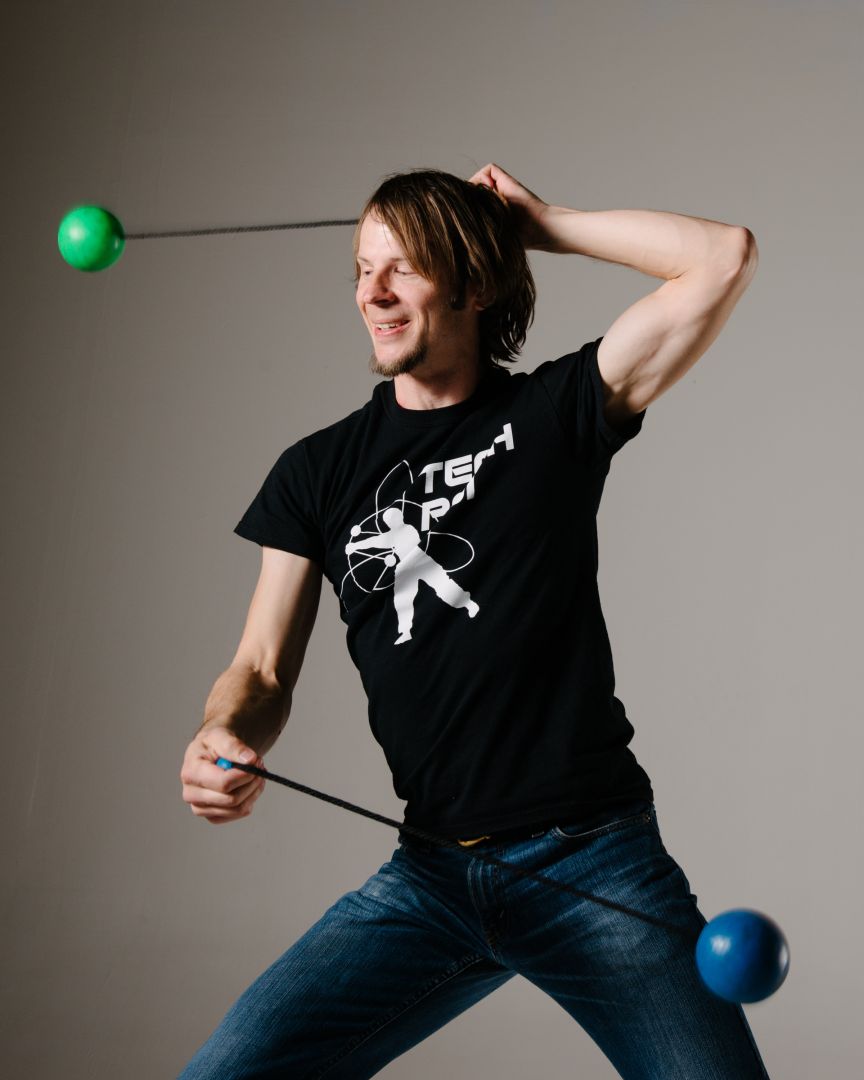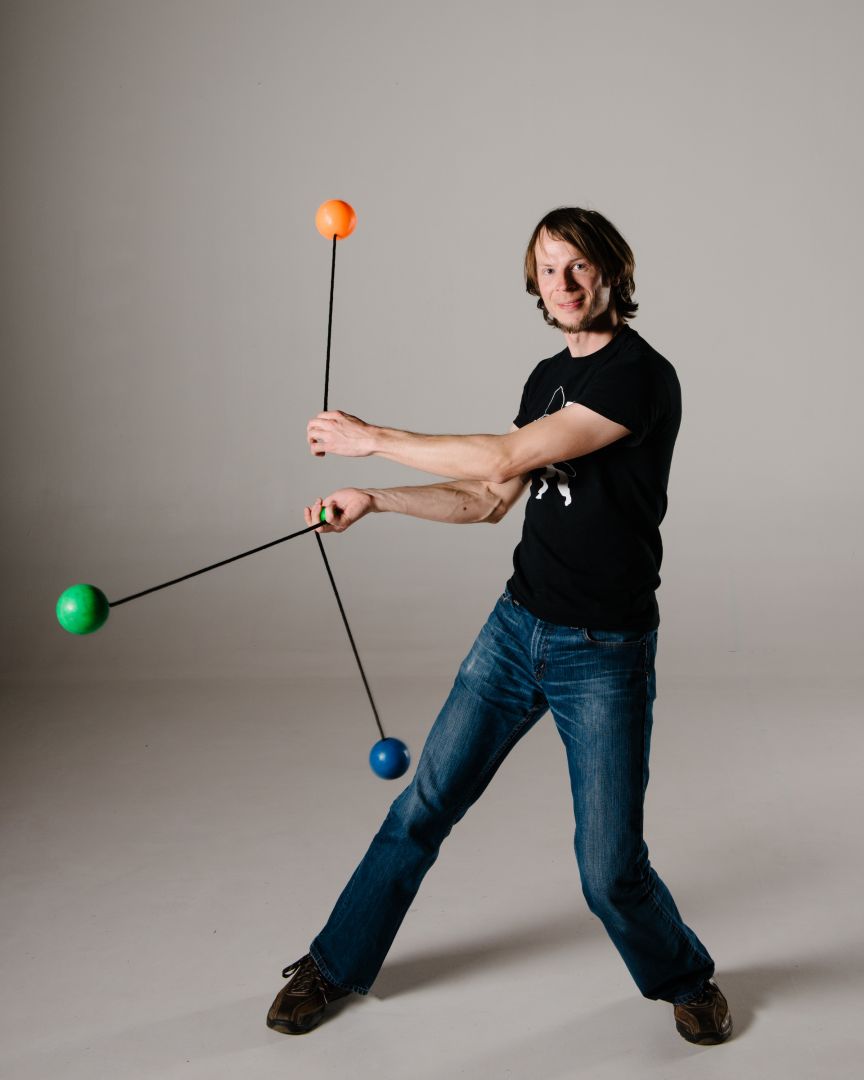Meet Drex | Flow Arts and Poi Spinning Content Creator

We had the good fortune of connecting with Drex and we’ve shared our conversation below.
Hi Drex, how does your business help the community?
I think in several ways:
The first is that by teaching people a difficult physical skill, it gives them a feeling of empowerment and self worth. One of my favorite moments is when I see someone learn a new trick for the first time and you see them go from thinking something is impossible to it being possible and just for a moment it’s like the entire world opens up for them. Those same skills can be applied to a variety of other avenues in their lives, so I like to think that teaching flow arts becomes a gateway to achievement not only with a prop but also with any other areas of a person’s life where they want to apply themselves.
Second there is creating connections between people in sometimes unexpected ways. A couple years ago I actually had a major crisis of faith in terms of whether there was actually any value in what I was creating. Then a young man sent me a video of himself performing some tricks I’d taught and revealed that he lives in Iran and had to practice poi on the downlow because it’s seen as a Western activity and could get him in serious trouble if word got out that he was doing it. I’d left traditional employment in the non-profit sector several years before partially because I had serious doubts as to whether the work was actually having a positive impact in the world. Getting this message from this young man suddenly made me realize that whether or not I could have an impact on changing the regime or laws in Iran, I could give this young man something he could do that could be just for himself in his living room and make his life a little brighter. And I realized that teaching people something as silly as spinning balls on strings could actually have a much more direct impact than anything else I’d done before.
Finally, I see the content I create as being a way to introduce my audience to ideas they might not otherwise be exposed to. Most people come to my channel looking for information on how to perform new poi tricks or reviews on products. I make sure to produce regular content on topics like racial justice, consent, masking and vaccine hesitancy, etc. It definitely make some people in my audience uncomfortable and I think that’s really the point–I can be a point of entry for them in asking themselves some important questions and examining their own views on the world around them. Frequently channels that focus on these issues exclusively fall into a pitfall of speaking more or less to the choir because they are the reason people sign up to follow those channels in the first place. By putting together a mix of content that caters to people looking to grow with a skill toy and then presenting these issues to people who stick around, I think I can become an entry point for them and I think having that role is important.

Alright, so let’s move onto what keeps you busy professionally?
I am a poi spinner and flow artist. I see myself as a dancer–someone who works to create moments with the movements of my body that embody emotions, ideas, and amazes the audience by showing them something they can appreciate for the value of the skill that goes into it. I seek to move with a prop as an extension of my being and another way to explore the underlying emotions and thoughts that I’m working with.
Originally poi spinning was just a fun hobby I picked up as a result of attending my first Burning Man back in 2006. After a year of exploring this hobby, I began uploading a weekly video to YouTube to track my progress and was shocked when the videos began to cultivate an audience. This led to opportunities to perform and teach all over the world and inspired me to leave traditional employment to see where this exciting and unexplored world was going to lead me.
Along the way I struggled to find ways to make my channel sustainable and truly build a business out of it. I faced ebbs and flows in the popularity and decline of the Flow Arts subculture that I was a part of. One of the most crucial insights I gained along the way was that, despite my niche being incredibly unique, there were templates that had been established for other businesses built around online content that I could learn from. Sometimes it was a real challenge figuring out how to apply those lessons to my own channel, but it was nonetheless a rewarding and informative journey.
At the core of what inspires me in this work, I like to show people that nothing is impossible for them. There’s a wonderful moment when someone performs a new trick for the first time that the impossible becomes possible and a whole world opens up to them. If they can learn a three beat weave, can they improve their own career? Friendships? Achieve a project they’ve wanted to do for ages? I like to think that Flow Arts can be a gateway into achievement and self worth and sometimes that journey can happen with something as silly as swinging a ball on the end of a string.

Let’s say your best friend was visiting the area and you wanted to show them the best time ever. Where would you take them? Give us a little itinerary – say it was a week long trip, where would you eat, drink, visit, hang out, etc.
Washington, DC has a wide array of amazing spots both on and off the beaten tourist path. Here are some of my favorites:
Almost nobody knows that the Franklin Roosevelt Memorial exists. It’s hidden in a grove of trees along the Tidal Basin between the Lincoln and Jefferson Memorials and features surprisingly understated architecture. It’s also a striking exploration of the middle years of the 20th century and the journey from the Great Depression to the end of the second World War. It isn’t just about Roosevelt himself but the world that he inhabited and the impact he tried to have on it. Every time I go there I discover something new.
If museums are your thing, there are a few spots I love to take people to: at the American History museum, there’s a large exhibit dedicated to the Star-Spangled Banner. I love taking people here and telling them the story of the bombardment of Fort McHenry up in Baltimore. How during the War of 1812, DC was sacked by the invading British. They worked their way up the coast lay siege to Baltimore on their way to ravage Philadelphia and New York. Francis Scott Key, a young lawyer, had been taking prisoner by the British and spent the night of the bombardment aboard one of the ships, watching the British pummel Fort McHenry into the wee hours of the night. He had every reason to think that when he woke up, the young country he belonged to would have collapsed. Instead he saw them raise the flag above the Fort and realized they’d not only survived the bombardment but also stopped the British fleet’s advance on the North. The victory would prove decisive and likely saved the entire country. I try to take people back to what it must have felt like to be aboard that ship and feeling like every hope was lost, only to see the following morning that a miracle had happened.
Additionally, there’s an exhibit on the first floor of the American History museum dedicated to American Innovation. It’s one of my favorite museum exhibits here because it’s dedicated not to individuals that had a huge impact on US history, but to the communities that gave rise to innovation. Information about Silicon Valley and Xerox PARC literally sits right next to a section on the birth of hip-hop in the Bronx in the 1970s and it’s incredible seeing how both great wealth and great poverty have given rise to important movements in American culture.
Over in Natural History, it’s hard to say no to the Deep Time as it’s been recently refurbished and now contains some of the most up to date information on dinosaurs, ice age mammals, and even the origins of life. This is one of those exhibits that has an easter egg hiding around every corner, so similarly I always feel like I discover something new every time I walk through it.
But I also like to take people upstairs to the Gem and Mineral halls. Specifically the room that the Hope Diamond is housed in. Not to show them the Hope Diamond, but to show them a 12-foot sheet of copper that sits along the North wall. Why? Because it carries with it the story of why my family is in this country. That sheet of copper is from a mine in the Upper Peninsula of Michigan. My great grandparents moved to the US from Finland at the turn of the 20th century specifically to take advantage of the economic opportunities the mines had created in what’s now called The Copper Country. It’s a little piece of my family’s history that I love to visit when I can and give visitors a little piece of mine and my family’s story.
For more local flavor, I like to take people to Malcolm X Park in Columbia Heights for the Sunday afternoon drum circle. This is a weekly tradition that has been going on for more than 50 years with an informal group of drummers getting together in the North end of the park to jam out for hours on end. It attracts with it a wide variety of dancers, flow artists, slack liners, and picnickers to hang out and intermingle. It’s one of the few events in the city that I see attracting people from all different backgrounds so it’s a remarkable way to get a good feeling for the city that exists around the seat of government in DC and realizing that it has a thriving culture all its own.
We could wrap up this whirlwind tour of the city by heading to my favorite local restaurant, Busboys and Poets. In addition to hosting a small bookstore alongside the eatery, Busboys frequently hosts artwork by local artists and events like comedy nights and poetry slams (COVID permitting). That and the menu is chock full of vegan and gluten-free options, so it is a delicious spot that’s a safe bet for everyone.

Who else deserves some credit and recognition?
If you like my content, be sure to check out BIPOC Flow Artistry on Instagram! This is a curated channel run by BIPOC Flow Artists to highlight voices and performers in the community that might otherwise be overlooked. Not only are the artists that they feature incredibly talented, they also pull them from a wide swath of different individual arts so there is always something new to see and appreciate. Check them out at http://instagram.com/bipocflowartistry


Website: http://drexfactor.com
Instagram: http://instagram.com/drexfactor
Twitter: http://twitter.com/drexfactor
Facebook: http://facebook.com/drexfactorpoi
Youtube: http://youtube.com/c/drexfactor
Image Credits
All photos taken by Devon Rowland
